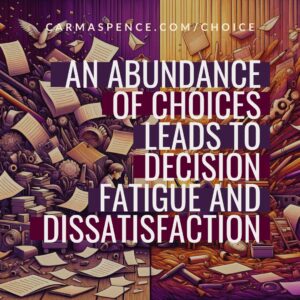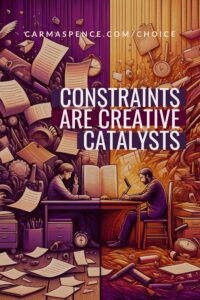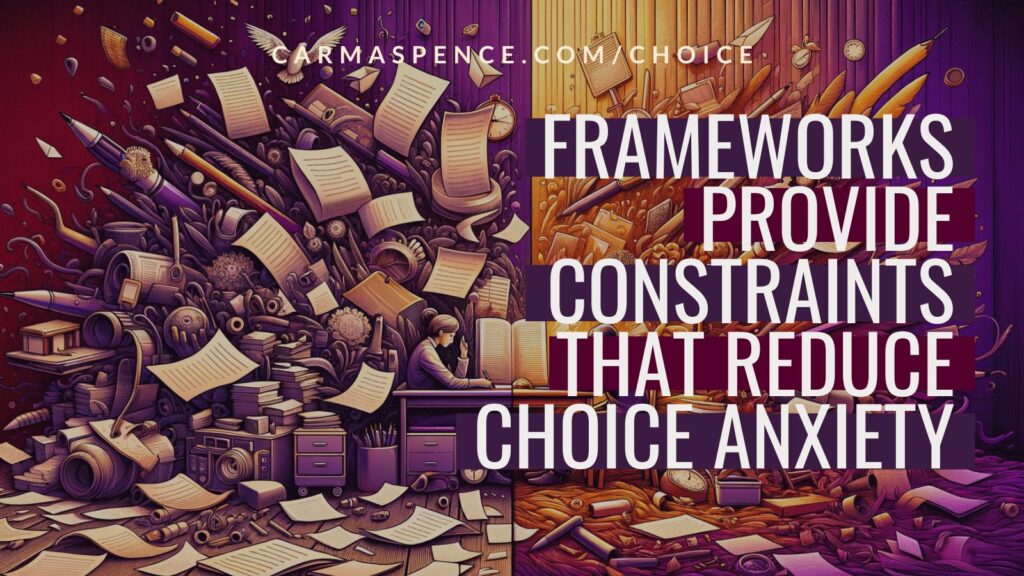I’ve observed that many, especially aspiring, authors believe that they need to be free of constraints to be truly creative. However, both my experience and research into the topic have proven the reverse to be true. In this article, I will explore the paradox of choice and how limitations encourage greater creativity for writers and authors.
The Paradox of Choice
In his book, The Paradox of Choice, Psychologist Barry Schwartz discussed the idea of choice overload, in which an abundance of choices might lead to decision fatigue and dissatisfaction. When writing a book, this means you might struggle with procrastination and writer’s block.A 2008 study published in the Journal of Creative Behavior, found that only those individuals experienced in the creative task benefited from having a larger selection of options.
Therefore, the question becomes: How can you install the right balance of creative choice and limitation to nurture your best creative potential?
Constraints as Creative Catalysts
The proverb says, “Necessity is the mother of invention.” In this context, necessity often means some form of constraint, which inspires creative thinking to overcome boundaries. Therefore, I invite you to trade in a belief that constraints hinder creativity for the research-based idea that constraints can be powerful creative catalysts.In an article published in the Harvard Business Review, Oguz Acar, Murat Tarakci, and Daan van Knippenberg reported that their review of 145 qualitative studies on the effects of limitations on creativity and innovation “found that individuals, teams, and organizations alike benefit from a healthy dose of constraints. It is only when the constraints become too high that they stifle creativity and innovation.”
What the studies revealed was that when constraints were fewer, people went with the most intuitive idea that came to mind, rather than work to develop better ideas. In contrast, when constraints were present, people were motivated “to search for and connect information from different sources to generate novel ideas for new products, services, or business processes.”
Constraints limit the scope of decisions, allowing you to focus more deeply on a narrower field of options. For instance, when you write a client-attracting book, it is better to focus on one specific problem your ideal clients wish to solve, rather than the larger transformation that you offer through your work. This limitation, rather than stifling creativity, encourages you to explore within your chosen boundaries, often leading to thoughtful and innovative writing.
Psychological Benefits of Frameworks
Frameworks introduce a set of predefined constraints that can help reduce the anxiety associated with too many choices. That’s why I structure my books and programs with frameworks. They give my readers and clients carefully constructed boundaries that help them reach greater creative potential.
For example, in It All Starts with an Idea, I provide a three-step process that helps you identify the best idea for a lead- and client-attracting book. Can you come up with a good book idea outside those steps? Possibly, but these three steps help focus you in on a specific type of book and set you up for greater potential success.
In the next book of The Authorneer’s Journey series, All You Need Is the Right Roadmap, I share my philosophy and framework for taking that idea and fleshing it out into a research-informed and flexible outline. Having an outline helps you stay on course so that your book has a better opportunity to meet its goals.
These frameworks help you move past choice overload and begin the process of writing, thereby boosting productivity and creativity.
Case Studies: Success Stories in Constrained Writing
Historical and contemporary examples abound where writers have thrived under constraints. Ernest Hemingway’s six-word story, “For sale: baby shoes, never worn,” is a classic example of how a severe limitation can produce a powerful narrative.One of my favorite poems is a haiku about a man missing his deceased wife:
the cold is piercing –
in the bedroom, I have stepped
on my dead wife’s comb
In a very few words, the poet communicates his deep sorrow.
In the business context, professionals who limit their focus to writing within their niche, and within focused sub-niches, often find it easier to develop clear, impactful content that resonates with their audience.
Applying Helpful Constraints
In light of the evidence that constraints can enhance your creativity, here are some strategies for applying this idea to your book-writing efforts.
Use an Outline
Creating an outline, or roadmap, for your book helps you focus in on your topic and not stray into tangents. It creates a flexible fence around your writing that helps you be more creative where it counts.
Implement Timed Writing Sessions
You might be surprised at how creative and productive you become when you set specific times for writing sessions. The pressure of a ticking clock can enhance focus and creativity.
Set Word Count Goals
Related to time limits, You can set daily or weekly word count targets to maintain a steady pace. This may also prevent the overwhelm and the feel of a daunting, endless project.
Zero In on a Small but Specific Topic
Choose a narrow subject matter or theme to explore in-depth. This can lead to more thorough and thought-provoking content, setting you up as a thought leader.
Conclusion
Embracing constraints can transform the overwhelming burden of choice into a liberating force that paves the way to clearer, more focused creative expression. By accepting and implementing positive limitations, you can navigate the complexities of choice overload and tap into your true creative potential. This approach not only enhances individual productivity but also leads to more meaningful contributions to your field of expertise.






0 Comments